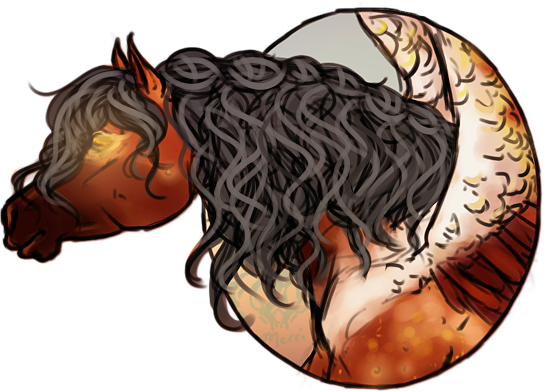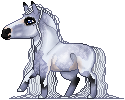She squints one eye shut, and places the other against the cool brass of the eyepiece.
The world becomes simultaneously smaller and bigger at once. Around her, the granite walls and spires fade to black as she gazes up through the curved lenses at the magnified stars—the old fossilized light blooming glumly in the pitch-black sky above. She follows a line from one star to the next, some large and some too small to have seen without her telescope’s aid, her jaw moving in pensive back-and-forth as she chews the inside of her cheeks.
When she has seen what she needs, she pulls back, blinking both eyes clear; the burnished telescope still hovering in the chill, montane moonlight between her and steep drop-off at her argent toes.
To her right, a piece of almost clean parchment hovers with a pot of ink and feather-quill. The geometric and scientific outlines of the new star chart are accounted for on the lamb’s skin. A large round circle with faint dotted lines of longitude and latitude and hemispheres, numbers and diagrams describing the rising and the falling of the sun and the lengths of seasons. Inside, is a world unmapped. A few stray stars and some of the old constellations that could still be seen, and marked in dark ink and illuminated with illustrations, hold their place.
Most of them are gone, cast into obliteration as the land below them had been.
So she starts a new labour of love and dedication.
The star-shed had told her the mountains were a good place to see Novus’ night sky, and of course, he was right. So she climbed the Armas to a protected precipice near the clouds; the cool, thin air reminding her of home—bringing her closer to the throne Cosmos once sat upon; closer to the enigmatic Caligo, yet a name on an altar she has not yet the heart to approach. The vastness of the universe opens like a book to her here, revealing upon its sable skin the formations and patterns of this strange land, like brilliant freckles. The guiding polestars, and the smaller clutches around them that make up the shapes of curved swords, pulled bows and arching swans.
With careful attention, she unknots their positions, placing them, one by one, on the suspended parchment. She pinches her lip between her teeth. Locating the correct position in the sky, with delicate mind’s grasp, she marks the first star of this new order, and then another, just left of the Father’s Mane, a constellation first discovered in Nordlys that still held its position all these many miles away. Between each new monument of dead light, she commands soft, dashed lines until they have become a new landmark by which to navigate at night, for those who know what to look for.
Stella pots the quill and nods, the parchment comes to hover in front of her in the air beside the glinting telescope. She considers the new constellation, tilts her head and bites the insides of her cheeks.
Pinches her lip between her teeth.
And begins to unravel its name.
The world becomes simultaneously smaller and bigger at once. Around her, the granite walls and spires fade to black as she gazes up through the curved lenses at the magnified stars—the old fossilized light blooming glumly in the pitch-black sky above. She follows a line from one star to the next, some large and some too small to have seen without her telescope’s aid, her jaw moving in pensive back-and-forth as she chews the inside of her cheeks.
When she has seen what she needs, she pulls back, blinking both eyes clear; the burnished telescope still hovering in the chill, montane moonlight between her and steep drop-off at her argent toes.
To her right, a piece of almost clean parchment hovers with a pot of ink and feather-quill. The geometric and scientific outlines of the new star chart are accounted for on the lamb’s skin. A large round circle with faint dotted lines of longitude and latitude and hemispheres, numbers and diagrams describing the rising and the falling of the sun and the lengths of seasons. Inside, is a world unmapped. A few stray stars and some of the old constellations that could still be seen, and marked in dark ink and illuminated with illustrations, hold their place.
Most of them are gone, cast into obliteration as the land below them had been.
So she starts a new labour of love and dedication.
The star-shed had told her the mountains were a good place to see Novus’ night sky, and of course, he was right. So she climbed the Armas to a protected precipice near the clouds; the cool, thin air reminding her of home—bringing her closer to the throne Cosmos once sat upon; closer to the enigmatic Caligo, yet a name on an altar she has not yet the heart to approach. The vastness of the universe opens like a book to her here, revealing upon its sable skin the formations and patterns of this strange land, like brilliant freckles. The guiding polestars, and the smaller clutches around them that make up the shapes of curved swords, pulled bows and arching swans.
With careful attention, she unknots their positions, placing them, one by one, on the suspended parchment. She pinches her lip between her teeth. Locating the correct position in the sky, with delicate mind’s grasp, she marks the first star of this new order, and then another, just left of the Father’s Mane, a constellation first discovered in Nordlys that still held its position all these many miles away. Between each new monument of dead light, she commands soft, dashed lines until they have become a new landmark by which to navigate at night, for those who know what to look for.
Stella pots the quill and nods, the parchment comes to hover in front of her in the air beside the glinting telescope. She considers the new constellation, tilts her head and bites the insides of her cheeks.
Pinches her lip between her teeth.
And begins to unravel its name.
@e-cho I'll let yo choose which babe!
☽



